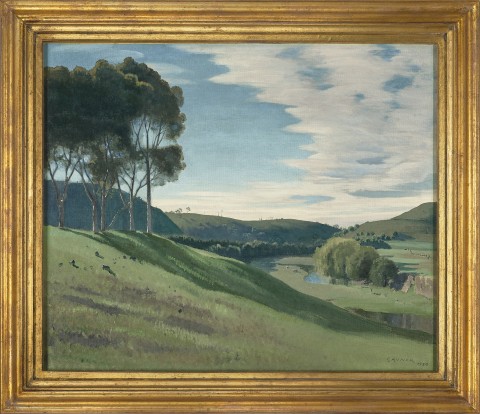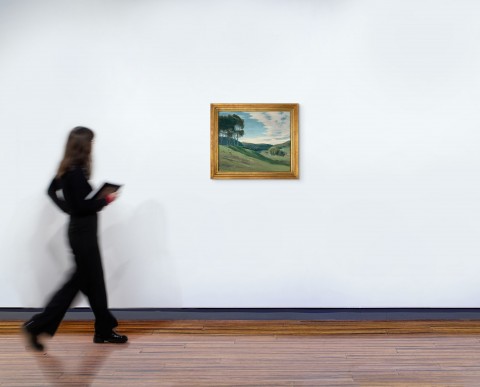MORNING, BACCHUS MARSH, VICTORIA, 1930
ELIOTH GRUNER
oil on canvas
50.5 x 61.0 cm
signed and dated lower right: GRUNER / 1930
inscribed with title verso: MORNING / Bacchus Marsh / Victoria
Elioth Gruner (possibly ledger no. 365, presented to the Returned Soldiers’ Imperial League c.1930)
Norman Schureck, Sydney, by 1958
Geoff K. Gray Auctions, Sydney, 28 November 1973, lot 44
Private collection
Christie’s, Melbourne, 14 March 1974, lot 432 (as ‘Bacchus Marsh, Victoria’)
Private collection, Sydney
Private collection, New South Wales
Norman Schureck Loan Exhibition, Art Gallery of New South Wales, Sydney, 27 May – 29 June 1958, cat.49
We are grateful to Steven Miller, Head of the Edmund and Joanna Capon Research Library and Archive, Art Gallery of New South Wales, for his assistance with this catalogue entry.
In the June 1930 edition of The Home magazine, it was announced that ‘Elioth Gruner, who has been painting in Victoria, has been sketching with George Bell and Darryl Lindsay in the Bacchus Marsh district.’1 Gruner was midway through an epic road journey that had taken him from Sydney down to Gippsland, and would subsequently include Adelaide before his return to Sydney in August. He was already one of Australia’s most celebrated landscape artists but was also notable for his considered response to new ideas concerning art, one result of which was his exploration of a mannered form of modernism since the mid-1920s. The fact that he was now painting alongside two well-known artist-peers on Woiwurrung and Wathaurong country in Bacchus Marsh implies that conversations regarding technique and approach would have been high on their agenda, and subtle results of these may be seen in the perfectly composed Morning, Bacchus Marsh, Victoria, 1930.
Gruner’s great love was light and its effect upon land cultivated by European hands. As a result, the broken brushwork of impressionism had influenced much of his early input with, for example, Spring frost, 1919 (Art Gallery of New South Wales) winning the prestigious Wynne Prize; he would eventually be honoured with the Wynne awards seven times during his career. In 1923, the British artist Sir William Orpen roundly criticised Gruner’s Valley of the Tweed, 1921 (which had also won the Wynne) in front of the artist whilst the painting was on exhibition in London. At first shocked by the encounter, Gruner subsequently travelled to France and began putting some of Orpen’s suggestions into practice, such as a greater emphasis on design, a flattening of forms and a heightening of colour, all of which may be detected in Morning, Bacchus Marsh, Victoria. In January 1930, Gruner’s On the Murrumbidgee won yet another Wynne and shortly after the announcement, he climbed into his Model A Ford and headed for Gippsland. Several significant works resulted including Mitchell River, Victoria (Deutscher and Hackett, 14 September 2022, lot 24) and Valley near Bairnsdale (Deutscher and Hackett, 10 November 2021, lot 47). Journeying further to join Bell and Lindsay in mid-April, he painted Morning, Bacchus Marsh, Victoria, plausibly one of the ‘24 by 20’ inch (50.5 x 61.0 cm) canvases he mentions in a letter to Basil Burdett, describing them as being ‘quite different to anything so far.’2 Of particular note is the powerful and dynamic interplay between the angled bank of clouds to the right and the contrasting copse of trees which counterbalance the soft curves of the hills and river below; such bold sky-versus-land interplays are not prominent in Gruner’s earlier work. In a companion painting done a few kilometres away, Myrniong, Victoria, 1930 (location unknown), he sets a similar bank of clouds to the alternate side, this time echoing the route of a country road. It is these harmonious yet dynamic contrasts which underscore Gruner’s opinion the Bacchus Marsh paintings were ‘different’; indeed, he subsequently wrote to Burdett of his triumphant belief that he had ‘painted a sky at last.’3
1. 'Art Notes', The Home: an Australian Quarterly, Art in Australia, vol. 11 no. 6, 2 June 1930, p. 13
2. Elioth Gruner. Letter to Basil Burdett, May 1930. Art Gallery of New South Wales archives. MS1995. 9, 1/17/09
3. Elioth Gruner. Letter to Basil Burdett, 29 May 1930. Art Gallery of New South Wales archives. MS1995. 9, 1/17/10
ANDREW GAYNOR


